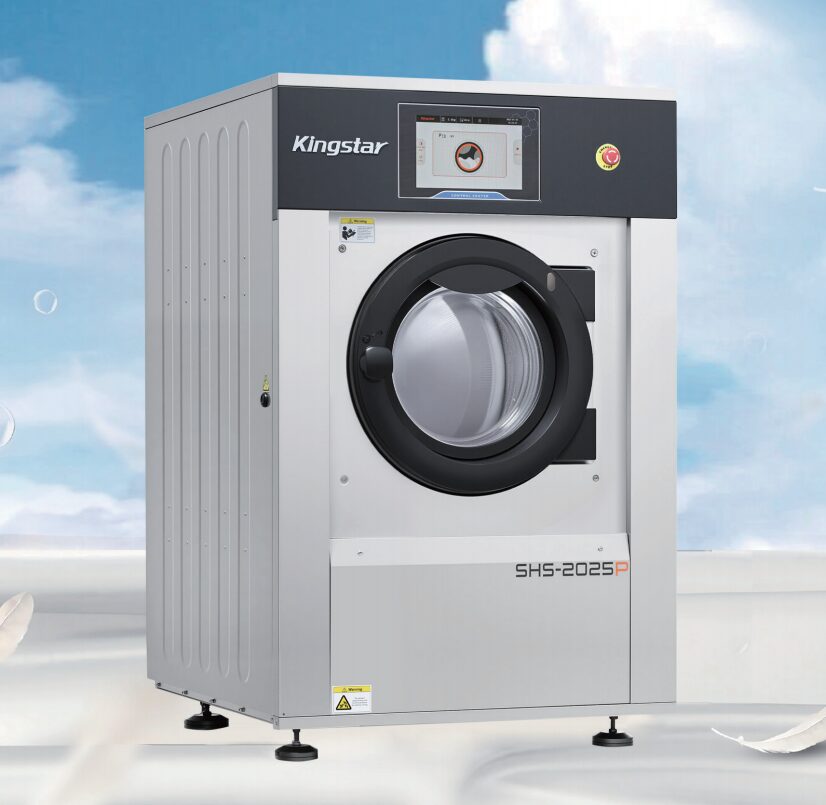There are 20 questions from basic principles to operational difficulties about dry cleaning technology. In the last article, we discussed the first ten questions. In this article, we will discuss the remaining ten questions.
Q11: Which Stains on Clothes must be treated before Dry Cleaning?
A11: The bloodstains, fruit stains, ballpoint marks, ink stains, and other large water-soluble stains should be removed before dry cleaning. Especially if bloodstains are not removed before dry cleaning, they will be heated during the dry cleaning process, and then they will solidify. At that time, it will be very difficult to remove them.
Q12: What are the Requirements for the Loading Quantity of Clothes during Dry Cleaning?
A12: The loading capacity directly affects the mechanical forces and the cleanliness of the washed clothes. In theory, it is ideal to wash 1 kilogram of clothing for every 18 to 20 liters of drum volume. Loading too many or too few clothes will reduce the machine’s cleaning and drying efficiency.

Q13: How to Use Detergent Concentrate in a Dry Cleaning Machine? How Many Types and Quantities of Clothes can a Bucket of Dry Cleaning Solvent Wash?
A13: The amount of detergent concentrate added is generally 1% of the volume of dry cleaning solvent, which is best. Adding too much or too little will affect the quality of the laundry.
- Washing Principles and Characteristics of the Detergent Concentrate
– The attraction between the stains and the detergent concentrate is larger than the attraction between the stains and the textiles. As a result, it has a strong capability of stain removal, which can separate the dirt from the fabric.
– The detergent concentrate has a hydrophilic group. It can make water (including the inherent moisture in garments and additional water added as needed) distribute evenly in the dry cleaning solvent so as to remove some water-soluble stains from garments.
– Anti-static electricity can prevent adsorption, thus preventing fine dust and dirt from adhering to the fabric surface during the drying process, and preventing the clothes from turning gray.
– It can prevent the redeposition of dirt and prolong the time of dirt redepositions.
– The washed clothes are bright and have a good luster.
- Function in the Pretreatment Process
The detergent condensate can also be formulated into a very good detergent and can be used for pre-wash treatment of clothes.
Formula: 6 parts dry cleaning solvent +2 parts detergent condensate +1 part water.
Method: Apply it to the dirtier parts of the clothes before dry cleaning. (collar and sleeves)
All clothes that have no chemical reaction to tetrachloroethylene can be dry-cleaned. At the same time, some oil-soluble buttons, decorations, and artificial leather cannot be dry-cleaned.
Q14: How to Dry Clean White Clothes and Light-colored Clothes?
A14: Washing white clothes, light-colored clothes have high requirements for the dry cleaning solvents. Its light transmittance must be over 70. That is, it must be pure dry cleaning solvent. Also, detergent concentrate must be added. The detailed operations are as follows.
Load the clothes → Drain the dry cleaning solvent thoroughly (detergent condensate has been added) to the high liquid level in the cylinder → Filter and circulate (18-10 minutes) → Drain the solvent to the bottom box → Spin dry (1 minute) → Dry (15 minutes) → Cool (5 minutes)
Q15: How to Clean the Silk Textiles? (Dry Cleaning)
A15: Because the silk clothes are light and delicate, we should better control washing, spin drying, and drying in the dryer. The detailed operations are as follows.
Load the clothes → Drain the dry cleaning solvent (detergent condensate has been added) to the high liquid level in the cylinder → Filter and circulate (6-8 minutes) → Drain the solvent → spin dry (1 minute) → dry (15 minutes) → cool (5 minutes).
Note: Silk textiles cannot withstand a large mechanical force, so they should be put in the mesh laundry bag before washing. The drying temperature should be lower than 50 degrees Celsius.
Also, when washing sweaters and ties, they are generally also washed in mesh laundry bags. The specific operation can be referred to when washing silk fabrics.
Q16: How to Clean the Silk Textiles? (Wet Cleaning)
A16: The silk products are delicate and gentle, and are easily damaged if the wrong cleaning method is chosen. As a result, people should pay attention to these aspects when washing silk textiles.
– Silk, like wool, is an animal fiber and has protein. Generally, the problems that occur in wool clothing also exist in silk fabrics. Silk fabrics themselves may also have some more difficult problems to handle. Increased elasticity after getting wet makes them unable to withstand mechanical force. Therefore, when washing silk with water, do not soak it in cold water for too long. Instead, wash them immediately after soaking. Do not apply excessive force and avoid twisting.
The structure of the textiles is complicated, and can generally be simply categorized into four types: silk, satin, gauze, and crepe.
– Some can be water-cleaned, while others are more suitable for dry cleaning. When doing water cleaning, people can mix a small amount of glacial acetic acid solution with water first, then soak the silk to be cleaned in the glacial acetic acid solution for color fixation. It helps reduce fading during washing. However, acetic acid may turn red garments’ color into a blotchy or blackish-red hue. Fortunately, the original color can be restored with an alkaline solution.
– Most silk textiles have a unique natural luster. To protect this luster, use a low-alkaline detergent or neutral detergent powder. The concentration of the laundry detergent liquid can be relatively dilute.
– The colors of the silk textiles are relatively bright. Most of the silk textiles are dyed with acid dyes, and the dyeing concentration is not high, so the temperature of the washing solution cannot be high. The actions of light, water, alkalinity, temperature, and mechanical forces can all make the textiles’ colors fade.
- Kingstar Wet Cleaning Machine
The lowest spin speed of the Kingstar wet cleaning machine is 15 rpm, and it can also achieve the safe washing of silk clothes by setting specific programs.
To avoid the above issues, washing should be done at room temperature or slightly warm temperature with a moderately fast speed. Also, soaking garments in the washing solution for a long time should be avoided. Additionally, no part of the fabric should be exposed above the washing solution because this may cause “fading irregularities” or “wrinkled streaks”. People should make every effort to protect the fabric material, preserve the texture, maintain the natural luster, and retain the bright colors so as to avoid the “shrinkage distortion” phenomenon.

Q17: Why is the Effect of Washing Individual Garment Poor?
A17: When washing clothes with a closed dry cleaning machine, a good tip is that the number of clothes in the drum should not exceed 80% of the rated capacity or be less than 50% of the rated capacity. When only one or two pieces of clothing are washed at a time, the mechanical effect is very small, and thus the decontamination effect is poor. The clothes just move around the edge of the drum. If necessary, people can add balancing clothes or substitutes to the drum to meet the loading requirements.
Q18: If Dry-cleaned Clothes Shrink, Is It Because There is too much Moisture in the Solvent?
A18: It is caused by the excessive moisture in the dry cleaning solvent.
- The excessive moisture can be caused by:
The addition of detergent condensate is too much, and it far exceeds the 1% volume ratio.
The clothes themselves are damp or have a large amount of moisture.
There is a problem with the water separator.
There is a leak in the steam pipeline.
- The methods to avoid too much moisture:
Completely dry all the clothes that have been pre-treated.
Dry the clothes that are relatively damp during collection.
Don’t add unnecessary dry cleaning auxiliaries.
If you find there is too much moisture in the washing machine, you can wash a batch of clean white towels or bed sheets to help remove excessive moisture. However, it doesn’t indicate the reasons for the moisture.
- Other tips:
Distill the solvent in the working tank.
Clean the button collector.
Clean the water separator.
Replace the filter if necessary.
Add new auxiliaries to the system.
Q19: Why do Black Stains Appear on the White Part of a Down Jacket after Washing?
A19: The fabric used in down jackets is usually treated with resin to be waterproof. Some coatings dissolve in dry cleaning solvents and will be washed off during dry cleaning. Once the coating is removed, the black feathers inside the down jacket will show through the surface, thus causing black stains. If you carefully observe it, you can identify the shape of the feathers. This phenomenon will be more obvious on the white or light-colored down jackets.
Sometimes, people use a lining cloth to fix feathers. Feathers can also react with this material and make the surface have black stains.
As long as the clothes are marked “dry-cleaning”, these stains are formed because of the structure of the clothes, not because of improper washing.
Q20: Why are there no Small Holes in the thinned Parts of the Polyester-Cotton Shirt?
A20: This kind of thinning is common. Sometimes, the cotton fibers may be damaged due to contact with chemical substances. (Acids, alkalis, and bleaches). These fragile fibers will be washed away during the cleaning process, leaving only a thin layer of polyester. Polyester fibers have stronger chemical resistance than cotton fibers.




